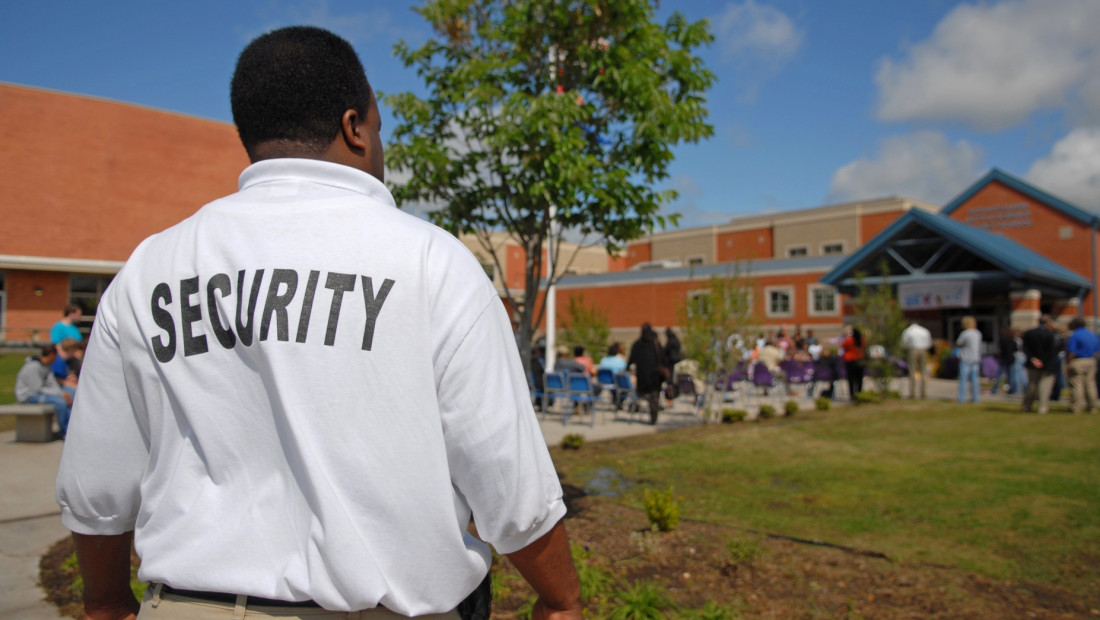
School hardening strategies - such as the use of security officers - was ranked third of four strategies for dealing with violence against teachers. -- Photo: Getty Images
For the first time, teachers in a nationwide study have told researchers what strategies they think work best to deal with student violence against educators.
Teachers rated suspending or expelling students as the least effective way of addressing violence, despite the popularity of “zero tolerance” policies in many school districts.
Instead, teachers rated prevention policies, such as counseling for troubled students and improving school climate, as the best strategy for dealing with violence.
“Teachers are the experts on the ground, and our results show that they believe prevention strategies are the ones that really work best in the schools, much more so than excluding kids who get into trouble,” said Andrew Perry, lead author of the study and a postdoctoral scholar in the Department of Educational Studies at The Ohio State University.

The study was published online recently in the journal School Psychology.
Results showed that schools’ use of exclusionary discipline practices – such as expulsion or suspension of students – was linked to a higher likelihood of teachers reporting violence against themselves. That could include verbal attacks and threats, and physical and property violence.
That may be because suspending or expelling students makes them angrier and leads to more violence, said study co-author Eric Anderman, professor of educational psychology at Ohio State.
“Removing the student doesn’t make the school safer in the long run,” Anderman said. “And it certainly doesn’t address the underlying issue of what caused the violent behavior in the first place.”
Data for the study came from a web survey, done in 2020-21, of 4,471 pre-K to 12th grade teachers from across the country.
Teachers reported on whether their school used 21 common safety measures. These measures fit into four categories. Along with exclusionary discipline and prevention measures, the other two categories were school hardening (such as use of metal detectors and security cameras) and crisis intervention (such as using physical restraint during violent episodes).
Teachers also rated their school’s effectiveness at using the 21 safety measures.
Results showed that more than 95% of teachers reported their schools used all four categories of school measures addressing violence.
Teachers rated prevention as the most effective strategy for dealing with violence. Crisis intervention was rated second, school hardening was third and exclusionary practices were rated as least effective.
In general, the more effective teachers thought strategies were at addressing violence, the less violence they reported against themselves, Perry said.

As mentioned earlier, use of exclusionary practices was associated with more reports of violence against teachers.
Use of prevention practices and school hardening had no association with teachers’ reports of violence. Use of crisis intervention was associated with a relatively small higher likelihood of violence.
Overall, the results show that the experiences of teachers agrees with previous research showing that suspending and expelling students doesn’t help make schools safer, Anderman said.
That’s concerning because, in some local school board elections, candidates have run on zero-tolerance policies that would make exclusionary policies even more entrenched.
“There are some people who think that the answer to school violence is to get the bad kids out of school, but our data shows that teachers don’t think that works,” Anderman said. “Other research supports that view.”
What does seem to work is prevention policies, Perry said. Offering counseling to students rather than keeping them out of school is one such measure. Another is to improve school climate so that teachers, students and administrators work together to make the school a place where they all want to be.
“These are proactive approaches that schools can use to try to reduce and prevent violent events before they occur,” Perry said.
Anderman said teaching social-emotional skills in school – such as self-awareness, self-control and interpersonal skills – can be an important part of violence prevention, even though some critics want schools to only focus on “reading, writing and arithmetic.”
This preventive approach is similar to that used by public health officials to prevent disease and chronic health issues.
“Public health experts know that it is easier and less costly to pay for a test that can identify a health problem early than to pay for treatment later,” Anderman said. “Schools can take a lesson from that to prevent violence.”
The study was part of the work of the American Psychological Association Task Force on Violence Against Teachers and School Personnel.
Other co-authors on the study came from the Center for Justice Innovation, Rutgers University, DePaul University, University of California, Los Angeles, University of North Carolina at Chapel Hill and the University of California, Berkeley.




